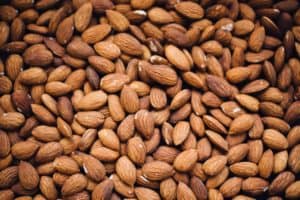Alternative flours are a great way to make keto-friendly baked goods, and thicken up bread and dough replacements for foods like pizzas, pancakes, and other types of breads.
There’s a ton of different kinds of flour alternatives on the market today, thanks to growing popularity of the paleo and keto diets, but not all of them are keto-friendly.
A common question I get a lot is about tapioca flour, and whether or not it should be used on the keto diet.
In this post, I’ll explain exactly what tapioca flour is, give the nutrition breakdown, and provide some info on other flour alternatives that I love to use for keto.
What Is Tapioca Flour?
Tapioca flour is an alternative type of baking flour that is derived from the crushed pulp of the cassava root.
Similar to other types of starches, tapioca flour is characterized as a fine, white powder that is commonly used in gluten free baking.
Tapioca flour can be used in a lot of recipes to replace cornstarch as a thickener for types of pies and sauces, and it also assists in creating a crisp crust and chewy texture in most variants of baked goods.
With it’s increasing popularity, more types of tapioca flour are becoming available in different stores and baked goods shops, and can be sold as ‘tapioca flour’ or ‘tapioca starch’, which are essentially the same thing and serve the same purposes.
At its core, tapioca flour is made up of almost entirely carbohydrates, and has very little protein, fiber or nutritional value.
In can also be found used in the production of certain types of fast foods and microwave meal products, because like other types of starches, it can serve as a binding agent that helps to keep foods like burgers and nuggets held together, without compromising the amount of gluten already in the recipe.
It’s also present in a lot of restaurant and pre-packaged soups and gravies because it is cheap, has a neutral flavor, and can help to thicken recipes without effecting the other ingredients.
Because of its gluten-free properties, tapioca flour is becoming widely used within the paleo diet community, but that doesn’t make it necessarily keto-friendly. I’ll explain why below.
Is Tapioca Flour Keto Friendly?
Tapioca flour often comes up in conversation, because it works so well on the paleo diet. However simply put, tapioca flour is not keto friendly.
Looking into the nutrition facts, you’ll see that just a 1/4 cup of tapioca flour actually has more carbohydrates than that of a 1/4 cup of standard wheat flour.
Another issue with tapioca flour are the other macros. Because it’s essentially a starch, almost all of the macronutrient value of tapioca flour comes from carbohydrates, with very little amounts of protein, fiber, or fat. It’s also highly caloric, with just one ounce coming it at around 100 calories.
Because the entirety of the keto diet is based around a goal of high-fat, low-carb eating, tapioca flour would easily throw you out of ketosis when adding to baked goods and dishes.
Tapioca flour is confusingly okay on the paleo diet, even though it’s a low carb diet, because that diet isn’t as restrictive when it comes to carbohydrate intake. The big difference between the paleo and keto diet is that keto requires you to maintain between 20-30 net grams of carb intake per day (maximum) in order to maintain a state of ketosis. With the paleo diet, there isn’t a measurable change in body state that you’re trying to achieve.
While tapioca flour is often suggested to those with gluten intolerances and allergies, there are still much better gluten-free alternative flours and starches that are also keto-friendly. I’ll get into my favorite keto-friendly flour options below.
Alternatives to Tapioca Flour
Almond Flour
Almond flour is another gluten-free alternative to flour, but unlike tapioca, it is low calorie and low carb, and rich in fiber as well.
A 1/4 cup serving of almond flour roughly has 6 grams of protein, 14 grams of fat, and only 6 grams of carbohydrates (3 net carbs from an additional 3 grams of fiber).
Because it is derived from almonds, that means that almond flour also has a lot of keto-friendly benefits when used in baking and cooking. Some key benefits of almond flour include:
- Improved cholesterol levels
- Stabilized blood sugar levels
- Good source of natural energy
- Good source of vitamin E, potassium, and magnesium
- It is a healthy fat
Almond flour is fairly easy to come by online and in most grocery stores, and can even be entirely made from scratch at home by blanching raw, skinless almonds, and then mixing together in a food processor.
Almond flour is extremely easy to bake with, and can be used to substitute flour in most traditional recipes. I usually prefer to order mine on Amazon.com, because I tend to go through a lot of it. Some of my favorite and trusted Almond flour brands include:
- Bob’s Red Mill Super-Fine Gluten Free Almond Flour
- Kirkland’s Signature Blanched Almond Flour
- Nature’s Eats Blanched Almond Flour
- Wellbee’s Super Fine Blanched Almond Flour
With almond flour, you can make a ton of great keto meals that you might be craving, especially if you’ve only just recently given up bread and normal flour. Some popular ideas include:
- Keto garlic bread
- Fathead flour pizza
- Keto meat pie
- Low carb banana waffles
- Low carb onion rings
- Eggplant fries
- Keto parmesan croutons
Coconut Flour
Coconut flour is another great and healthy choice, especially for those that might be too allergic to almond flour because of tree nut allergies.
When substituting almond flour for coconut flour, a good rule of thumb is using about 1/3 cup of coconut flour in place of 1 whole cup of almond flour.
Coconut flour is also very keto-friendly, it’s also rich in fats, proteins and fiber, and is very low in net carbs. Additionally, it has a low glycemic index level, meaning it won’t spike your blood glucose levels or risk knocking you out of ketosis. Looking at the nutrition facts, one quarter cup serving (roughly 30 grams) of coconut flour contains:
- 10 grams of fiber
- 16 grams of carbohydrates (6 net carbs)
- 4 grams of fat
- 6 grams of protein
- 3.6 milligrams of iron
- 120 calories
Along with being keto-friendly, and friendly for those with gluten sensitivities and diabetes, coconut flour has a lot of the same benefits as coconuts.
Some of the biggest benefits include:
- Assists in maintaining healthy blood sugar levels
- Can help lower bad cholesterol levels
- Boosts metabolism regulation
- High in fiber to prevent constipation and other digestion issues
- Reduces risk of heart disease
Like almond flour, coconut flour is also easily available online and in most grocery stores. What’s even better is that it’s also much cheaper, and less of it needs to be used in most recipes. Some of my favorite brand of coconut flour are:
- TerraSoul Super Foods Organic Coconut Flour
- Anthony’s Organic Coconut Flour
- Nutiva Coconut Flour
- Anthony’s Organic Shredded Coconut
Pecan Flour
Pecans, like almonds, are tree nuts, and come with a similar range of health benefits and versatility when processed into flour.
One big bonus here is that pecans contain less carbs and calories than almonds, and less than most types of nuts in general. In fact, a 1/4 cup of pecan flour contains less than one single net carb!
Like almond flour, pecan flour can generally be used to substitute regular flour in the same cup for cup proportions, making it an easy alternative for a lot of baking recipes.
Some of my favorite brands of pecan flour include:
Flax Meal
Flax meal is essentially just ground up flax seed, which has a lot of beneficial uses for the keto diet.
When flax seeds are ground into a meal, it allows the fiber and nutrients within the seeds to be more easily absorbed by the body.
Better yet, a single serving of flaxseed meal has 6 grams of carbs and 6 grams of fiber, meaning zero net carbs!
One serving of flax meal also comes with 8.5 grams of fat (rich in Omega-3 fatty acids) and 4 grams of protein, making it a great way to get closer to hitting your keto macros.
Some of my recommended brands of flax seed are:
Bob’s Organic Brown Flaxseed MealGerb’s Allergy Friendly Flaxseed MealTrader Joe’s Organic Flaxseed Meal
Xanthan Gum
Xanthan gum technically isn’t a flour, but a thickening agent. So you’ll still likely need a little bit of nut flour to go along with it.
This means that it helps to allow dough to stretch and rise just as it would with any type of regular flour. This is great for meals like pizza, which require rolled out and stretched dough.
Another benefit of xanthan gum is that it has been linked to naturally lowering blood sugar levels, especially after eating. It’s also shown to have cancer-fighting properties, and can assist with lowering cholesterol
When used for keto baking, adding xanthan gum to a nut or seed flour will help to create that same effect. My recommended brands of xanthan gum are:
- Anthony’s Xanthan Gum
- Bob’s Red Mill Gluten Free Xanthan Gum
- WillPowder Xanthan Gum
- Cape Crystal Xanthan Gum
Final Thoughts
As we’ve seen above, I definitely wouldn’t recommend tapioca flour for the keto diet, especially when there are so many other low carb options easily available.
While it is gluten free and paleo-friendly, there’s still so many others that are good for those with gluten intolerances, diabetes, and trying to stick to the keto diet.
Do you have any favorite almond, coconut, or pecan flower recipes? Let me know in the comments below!



So when looking for a dairy free milk powder alternative, I find that most organic powders available in the UK contain 2.5% maltodextrin from tapioca starch. Is that also too high in carbs? I want to create my own ‘hot chocolate’ powder and need a dairy free milk powder for that, because usually there’s no alternative for milk available – except for soy, which I won’t touch to safe my life! Thank you!
Thanks for your question! That 2.5% maltodextrin from tapioca starch isn’t inherently high in carbs, and it is okay in moderation. Maltodextrin can just contribute to spikes in high blood sugar, which is bad for maintaining a state of ketosis, so you should only consume it sparingly. A dessert like that sounds like a good example of an okay way to use it.
I wrote an article on maltodextrin that might clear that up for you too here – https://www.ketolifehacker.com/2019/05/09/maltodextrin-keto/
I have recipes that call for low amounts of tapioca flour. Such as 1-2 tbs in a loaf of bread. Can I just omit this or what could I use instead? Xatham Gum or Arrowroot?